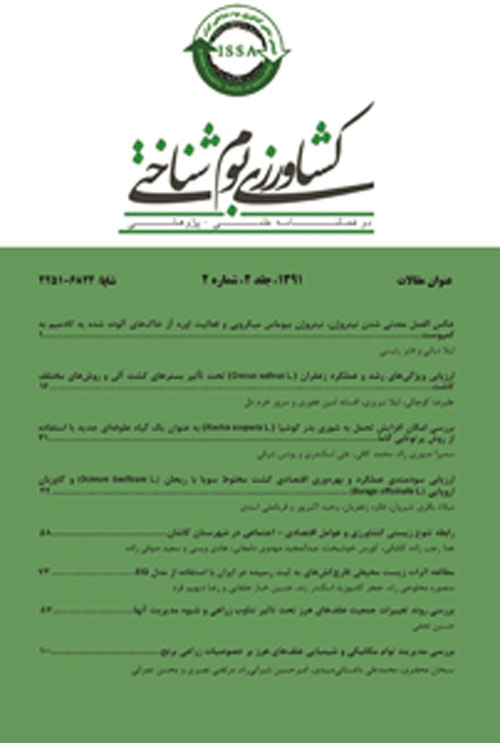Assessment of morphological variation in susceptible and resistant populations of wild oat to ACCase-inhibitor herbicides using quantitative and qualitative characters
Author(s):
Abstract:
In this research, in order to evaluate morphological diversity of wild oat populations, Principal component and cluster analyses were used in 59 populations of Avena fatua and Avena sterilis ssp. ludoviciana which were sensitive or resistant to ACCase inhibitor herbicides and belonged to different parts of Iran, using 20 quantitative and 12 qualitative characters. With the principal component analyses, the first 7 principal component contributed 72/97% of the variability amongst populations, which justified following characters, respectively: the first principal component (with 21/97 % of the total variation) rachis length, panicle length, ligule length and leaf width characters, the second principal component (with 16/26 % of the total variation) length of spikelet without awn, upper and lower glume length characters, the third principal component (with 10/27 % of the total variation) upper and lower glume width, teeth of lemma ending length of first floret and callus length characters, the fourth principal component (with 7/28 % of the total variation) number of nerves in the upper glume, awn length in the first floret and number of nerves in first floret lemma characters, the fifth principal component (with 6/27 % of the total variation) number of nerves in the lower glume, lemma length in the first floret and palea length in the first floret characters, the sixth principal component (with 5/62 % of the total variation) rachila length character and seventh principal component (with 5/28 % of the total variation) number of florets. Cluster analyses showed high morphological variation while no relationship between genetic divergence and geographical origins in populations was observed. Moreover, it was shown that dendrogram of cluster analyses based on qualitative traits, can differentiate two studied taxons and neither qualitative nor quantitative characteristics could separate populations based on their resistance to ACCase inhibitor herbicides. Results of this research can be useful in the genus Avena and it´s species germplasm management in Iran.
Keywords:
Language:
Persian
Published:
Journal of Agroecology, Volume:2 Issue: 1, 2012
Page:
48
magiran.com/p1250057
دانلود و مطالعه متن این مقاله با یکی از روشهای زیر امکان پذیر است:
اشتراک شخصی
با عضویت و پرداخت آنلاین حق اشتراک یکساله به مبلغ 1,390,000ريال میتوانید 70 عنوان مطلب دانلود کنید!
اشتراک سازمانی
به کتابخانه دانشگاه یا محل کار خود پیشنهاد کنید تا اشتراک سازمانی این پایگاه را برای دسترسی نامحدود همه کاربران به متن مطالب تهیه نمایند!
توجه!
- حق عضویت دریافتی صرف حمایت از نشریات عضو و نگهداری، تکمیل و توسعه مگیران میشود.
- پرداخت حق اشتراک و دانلود مقالات اجازه بازنشر آن در سایر رسانههای چاپی و دیجیتال را به کاربر نمیدهد.
In order to view content subscription is required
Personal subscription
Subscribe magiran.com for 70 € euros via PayPal and download 70 articles during a year.
Organization subscription
Please contact us to subscribe your university or library for unlimited access!


